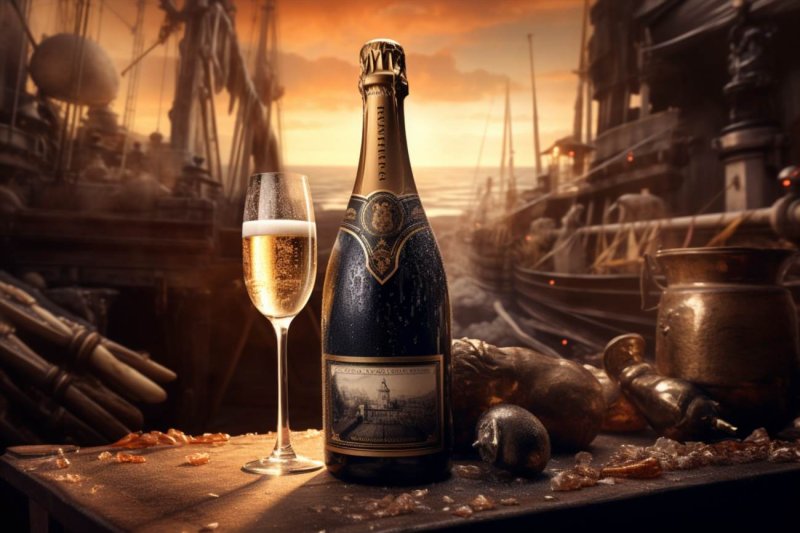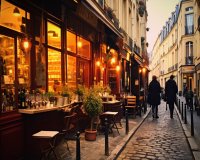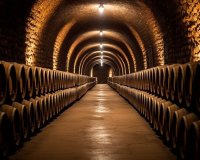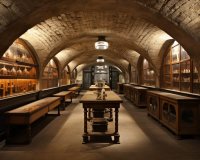The History of Champagne: How France’s Famed Fizz Came to Be

The History of Champagne: How France’s Famed Fizz Came to Be
When one thinks of luxury and celebration, Champagne often comes to mind. This effervescent beverage has a rich history that is deeply intertwined with the city of Paris and the Champagne region of France.
Champagne, a sparkling wine, has long been associated with opulence and merriment. But how did this iconic drink come into existence, and what role did Paris play in its story? Let's delve into the fascinating history of Champagne.
The Birth of Bubbles
The story of Champagne dates back to the early days of winemaking in the Champagne region of northeastern France. In the 17th century, winemakers in this region began experimenting with various winemaking techniques, including the double fermentation process that creates bubbles in the wine.
One of the key figures in Champagne's history is Dom Pérignon, a Benedictine monk who made significant contributions to the refinement of Champagne production. While the popular legend attributes the discovery of Champagne to Dom Pérignon, it's more likely that he played a crucial role in improving its quality and consistency rather than inventing it.
The effervescence in Champagne was initially seen as a flaw by winemakers, and efforts were made to eliminate it. However, over time, the unique and effervescent character of the wine gained favor among the aristocracy in Paris.
Paris: The Epicenter of Elegance
Paris, often referred to as the "City of Light," has always been a hub of culture, fashion, and refinement. It didn't take long for Champagne to find its way into the vibrant social scene of the French capital. In the 18th century, Champagne became the drink of choice among the Parisian elite.
Salons, grand parties, and soirées held in Parisian châteaux featured Champagne as a symbol of luxury and celebration. The French monarchy and nobility embraced this sparkling wine, cementing its association with grandeur and sophistication.
Champagne's popularity in Paris had a profound impact on its production. Winemakers in the Champagne region began to refine their techniques to meet the growing demand for this effervescent delight. The development of stronger glass bottles and corks capable of withstanding the pressure of Champagne's bubbles further contributed to its success.
The Rise of Champagne Houses
As Champagne gained prominence in Parisian high society, the concept of Champagne houses emerged. These prestigious establishments, such as Moët & Chandon and Veuve Clicquot, were responsible for producing and marketing Champagne on a larger scale. They played a crucial role in establishing Champagne as a global symbol of celebration.
The 19th century saw Champagne houses perfect the art of blending different grape varieties to create consistent and exceptional cuvées. These blends became highly sought-after and are still cherished today for their unique flavor profiles.
Champagne Today
Today, Champagne is a worldwide symbol of festivity and luxury. It is enjoyed on occasions ranging from weddings and anniversaries to New Year's Eve celebrations. The Champagne region in France continues to produce some of the finest sparkling wines in the world, with strict regulations in place to maintain its quality and authenticity.
Paris, with its historic connection to Champagne, remains a prominent market for this beloved bubbly. The city's many Champagne bars, bistros, and restaurants offer visitors a chance to savor the effervescence that has enchanted Parisians for centuries.
In conclusion, the history of Champagne is a tale of innovation, elegance, and the enduring bond between a region and a city. From its humble beginnings in the Champagne region to its exalted status on the streets of Paris, Champagne has become a timeless symbol of joy and celebration.
Paris: Food and Wine Tasting Walking Tour in Le Marais
Explore the Culinary Delights of Le Marais
Indulge in a delectable journey through Paris' Le Marais neighborhood, savoring a blend of traditional and contemporary French cuisine.
Highlights:
- Enjoy 11 food samples and 2 drinks across 8 eateries
- Visit the oldest covered market in Paris
- Explore the heart of Paris's old Jewish quarter
- Lunch like a Parisian at a classic bistro
- Discover the last few family-run businesses in the Marais
Embark on your tour with a quintessential French experience: a flaky butter croissant from one of the city’s beloved bakeries. Delight in homemade sourdough bread and learn about the family behind this local favorite.
Continue your journey with a visit to a master chocolatier, awarded the prestigious title of Meilleur Ouvrier de France. Indulge in high-quality chocolates, a testament to the craft's excellence.
Experience a hidden gem of local cuisine at a food market, where chickpea pancakes await. Explore Paris' Jewish quarter on a brief historical walk, immersing yourself in the area's century-old traditions.
Step into a bakery, operated by a family steeped in tradition, and relish unique pastries. Gain insight into the French approach to produce shopping while savoring a delightful selection of cheeses and cured meats.
At the next stop, savor a delicious French onion soup made from locally sourced, scratch-made ingredients. This establishment began as a protest against fast food and remains committed to its ethos.
Experience a pastry unlike any other, as Syrian flavors blend with French patisserie techniques at a French-Syrian bakery.
Conclude your culinary adventure with a glass of wine at a spot specializing in natural wines. Meet the owner and delve into the fascinating world of natural wine-making.
Includes:
- Local English-speaking guide
- Guided walking tour
- 11 food tastings and 2 half glasses of wine across 8 family-run establishments in Le Marais
- Hotel pickup and drop-off
- Tips
Meeting Point
Meet your guide in front of Les Succulents Cactus Store. Your guide will be holding a red Devour tote bag.
Open in Google Maps
Important Information
What to bring: Outdoor clothing
Know Before You Go:
- The tour utilizes multiple areas that are not wheelchair accessible. Those with wheelchairs should contact the provider beforehand to make a suitable itinerary.
- This tour is not suitable for vegans, or those with lactose intolerance.
- This tour is adaptable for vegetarians, pescatarians, gluten-free (not celiacs), dairy-free, non-alcoholic, and pregnant women.
- If you have a dietary requirement or food allergy, please note it when booking.
- Guests with serious food allergies will need to sign an allergy waiver at the start of the tour.
- Due to the risk of gluten cross-contamination, this tour is not adaptable for those with celiac disease.
The Origins of Champagne and Its Cultural Impact
Champagne, often associated with celebration and luxury, has a rich history dating back centuries. Its origins can be traced to the picturesque vineyards of the Champagne region in France, just a short distance from the bustling city of Paris.
The Birth of Bubbly Elegance
The story of Champagne begins with the meticulous craftsmanship of Benedictine monks in the early 17th century. They were among the first to intentionally produce sparkling wine by bottling it before the initial fermentation process was complete. This resulted in the characteristic effervescence that defines Champagne.
The Terroir of Champagne
The Champagne region, situated in northeastern France, boasts a unique terroir that contributes to the distinctive taste of its wines. The chalky soil, cool climate, and gently rolling hills create an ideal environment for cultivating the grapes used in Champagne production, primarily Chardonnay, Pinot Noir, and Pinot Meunier.
Dom Pérignon and the Evolution of Champagne
A pivotal figure in the history of Champagne is Dom Pérignon, a monk who, contrary to popular belief, did not invent sparkling wine but made significant contributions to its refinement. He perfected techniques in blending grapes and improving the quality of the wine, earning him a legendary status in the Champagne world.
Champagne’s Royal Affair
Champagne soon found favor with the French monarchy, notably King Louis XIV, who dubbed it "the only wine a gentleman can drink." Its association with royalty and nobility elevated its prestige and popularity both within France and on the international stage.
The Global Spread of Champagne
By the 18th century, Champagne had gained popularity beyond France’s borders. Its reputation for excellence in craftsmanship and taste reached the courts of Europe, solidifying its status as the drink of choice for celebrations and momentous occasions.
The Industrial Revolution and Champagne
The advent of the Industrial Revolution brought about advancements in bottling, corking, and storage techniques, enabling Champagne to be produced on a larger scale and distributed worldwide. This marked a turning point in Champagne’s accessibility and global influence.
Champagne in the Arts and Culture
Champagne’s cultural impact extends far beyond its consumption. It has inspired artists, writers, and filmmakers, becoming a symbol of opulence, sophistication, and joie de vivre. From Impressionist paintings depicting leisurely Champagne-filled gatherings to F. Scott Fitzgerald's "The Great Gatsby," where Champagne flowed freely during the roaring twenties, it has become an enduring muse in various forms of artistic expression.
Modern Champagne Culture
Today, Champagne remains synonymous with celebration and luxury. It graces the tables of the world's most prestigious events and continues to be a staple in toasts and milestones. Its production is governed by strict regulations to preserve its quality and reputation.
Conclusion
In conclusion, the origins of Champagne in the bucolic vineyards of the Champagne region, coupled with its cultural impact, have solidified its place in history. From its humble beginnings with monks to its global influence, Champagne has become an enduring symbol of elegance and festivity.
Montmartre Cheese, Wine & Pastry Guided Walking Tour in Paris
Explore the culinary delights of Montmartre, Paris, on this guided walking tour that takes you on a gastronomic adventure through charming streets and iconic landmarks.
Indulge your senses as you meet passionate food artisans and savor a variety of exquisite French delicacies, including fresh cheeses, charcuterie, pastries, and chocolates, all perfectly paired with fine wines. This immersive experience offers a unique opportunity to taste the authentic flavors of Montmartre.
During this 3-hour tour, enjoy panoramic views of Paris from the Sacré Coeur, one of the city's most iconic landmarks. Stroll along cobblestone streets, admire quaint cafes, and soak in the Parisian ambiance as you learn about the rich history and culture of Montmartre.
Accompanied by a knowledgeable local foodie guide, discover the hidden gems of Montmartre, from the famous Place du Tertre to the legendary Moulin Rouge. Learn about the artistic heritage of the area, once home to renowned figures like Toulouse-Lautrec and Pablo Picasso.
This small-group tour ensures an intimate experience, allowing you to interact with the food artisans and fellow enthusiasts. Immerse yourself in the vibrant atmosphere of Montmartre and create unforgettable memories as you indulge in delectable treats and exquisite wines.
Join us for this culinary journey and uncover the culinary secrets of Montmartre, one bite at a time.
Meeting Point: Outside the Starbucks shop and the pharmacy, near Blanche Metro station (Line 2).
Important Information: Please wear comfortable shoes and weather-appropriate clothing. Some walking is involved in this tour.
The Secrets Behind Champagne's Production and Region Paris
Champagne, a world-famous sparkling wine, is synonymous with celebration and luxury. Its production is steeped in tradition and guided by strict regulations, making it a unique and cherished beverage. The region of Paris plays a significant role in the history and production of Champagne.
Champagne Production Process:
Champagne production involves a meticulous and complex process. The primary grape varieties used in Champagne production are Pinot Noir, Chardonnay, and Pinot Meunier. The first step is grape harvesting, where the grapes are carefully selected and handpicked to maintain quality.
The grapes are then pressed to extract the juice, which undergoes fermentation. After the initial fermentation, the winemaker blends different wines to create the desired flavor and character. This blend is then bottled with additional yeast and sugar, initiating a second fermentation.
During the second fermentation, the carbon dioxide created is trapped in the bottle, giving Champagne its effervescence. The wine is left to age on its lees, developing its unique taste and aroma. The aging process can vary, with non-vintage Champagnes aging for at least 15 months and vintage Champagnes aging for a minimum of 3 years.
The Importance of the Paris Region:
While Champagne production is often associated with the Champagne region in France, the influence of Paris on its history and marketing is undeniable. Paris, as a major cultural and economic hub, has been a significant market for Champagne since its early days.
Historically, Paris served as a crucial distribution point for Champagne, allowing this exquisite beverage to reach a broader audience. The high demand for Champagne among the aristocracy and elites in Paris propelled its reputation and popularity, establishing it as a symbol of luxury and prestige.
Regulations and Appellations:
Champagne is protected by stringent regulations to maintain its authenticity and quality. The production is regulated by the Appellation d'Origine Contrôlée (AOC) system, which dictates the precise methods and regions eligible for Champagne production.
Only grapes grown in specific areas of France, including the Champagne region and neighboring regions like Paris, can be used to produce Champagne. The AOC system ensures that the traditional methods and standards are upheld, guaranteeing consumers a genuine Champagne experience.
Conclusion:
Champagne's production is a blend of tradition, craftsmanship, and strict adherence to regulations. The role of the Paris region in Champagne's history and distribution cannot be overstated. As you enjoy a glass of Champagne, you can appreciate not only its effervescence but also the rich heritage and meticulous craftsmanship behind this iconic sparkling wine.






